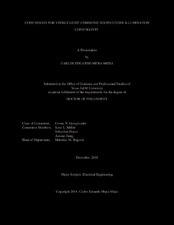| dc.contributor.advisor | Georghiades, Costas N | |
| dc.creator | Mejia Mejia, Carlos Eduardo | |
| dc.date.accessioned | 2019-01-23T20:50:55Z | |
| dc.date.available | 2020-12-01T07:31:43Z | |
| dc.date.created | 2018-12 | |
| dc.date.issued | 2018-11-21 | |
| dc.date.submitted | December 2018 | |
| dc.identifier.uri | https://hdl.handle.net/1969.1/174530 | |
| dc.description.abstract | Visible light communication (VLC) uses the same LEDs which are an efficient source of illumination
to transmit information concurrently using optical direct-detection. As a result of modulating
the LED to convey information, there may be a perceived change in the light perception
which besides being annoying, may produce physiological consequences under prolonged exposure.
The aim of this research is to propose code design methodologies for controlling the effects
of light intensity flickering, brightness control, and color shifts due to the modulation, encoding
information bits in organized optical symbol sequences, and improving the coding gain by the use
of the Viterbi algorithm.
In order to mitigate the effect of intensity flickering presented in On-Off Keying modulation,
five codes are designed with two proposed algorithms using finite-state machines (FSMs) for constraining
the runs of zeros or ones. The codes are compared with the codes proposed in the IEEE
802.15.7 standard on VLC (Manchester code, 4B6B code, and the 8B10B code) in terms of flicker
mitigation using the perceived flicker index (PFI) (a mathematical measure of flicker introduced in
this study) and error-rate performance. The designed codes show asymptotic coding gains between
1:25 and 6 dB with a low sacrifice in PFI.
To avoid color shifts in color-shift keying (CSK) modulation, four codes were designed from
optimally CSK constellations and two classes of codes where one class is based on FSMs and
the other on trellis-coded modulation (TCM) according to the desired color perception constraint.
The designed codes show asymptotic coding gains between 1:5 to 3:5 dB with respect to uncoded
transmission.
For brightness control, variable-weight multipulse pulse-position modulation (VW-MPPM) is
introduced as an alternative for increasing the spectral efficiency by the selection of multipulse
pulse-position modulation symbols of diverse weight to attain the desired dimming level. Combining
VM-MPPM symbols with Huffman codes and TCM, two designed codes are compared with
MPPM codes for dimming level of 0:67 and 0:40 showing an asymptotic coding gain of 0:94 and
1:29 dB, respectively.
Finally, we show the trade-offs between coding gain improvement and their effects on light
perception. | en |
| dc.format.mimetype | application/pdf | |
| dc.language.iso | en | |
| dc.subject | Visible light communications | en |
| dc.subject | Illumination constraints | en |
| dc.subject | Viterbi-algorithm | en |
| dc.subject | channel coding | en |
| dc.subject | soft-decision decoding | en |
| dc.subject | Color-shift-keying | en |
| dc.subject | On-Off Keying | en |
| dc.subject | Multipulse pulse-position Modulation | en |
| dc.subject | CSK | en |
| dc.subject | OOK | en |
| dc.subject | MPPM | en |
| dc.title | Code Design for Visible Light Communications Under Illumination Constraints | en |
| dc.type | Thesis | en |
| thesis.degree.department | Electrical and Computer Engineering | en |
| thesis.degree.discipline | Electrical Engineering | en |
| thesis.degree.grantor | Texas A & M University | en |
| thesis.degree.name | Doctor of Philosophy | en |
| thesis.degree.level | Doctoral | en |
| dc.contributor.committeeMember | Jiang, Anxiao | |
| dc.contributor.committeeMember | Hoyos, Sebastian | |
| dc.contributor.committeeMember | Miller, Scott L. | |
| dc.type.material | text | en |
| dc.date.updated | 2019-01-23T20:50:57Z | |
| local.embargo.terms | 2020-12-01 | |
| local.etdauthor.orcid | 0000-0003-2176-5435 | |


